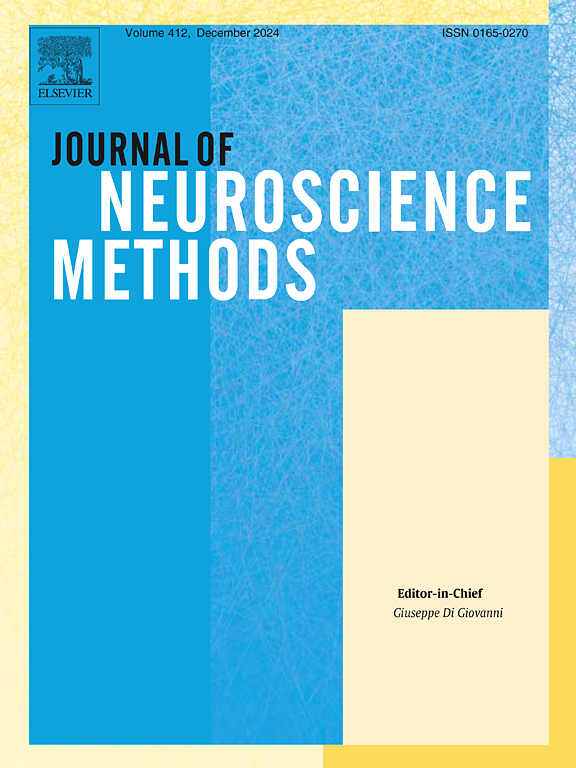STSimM:一种评估神经元模型性能和检测尖峰序列相似性的新工具。
IF 2.7
4区 医学
Q2 BIOCHEMICAL RESEARCH METHODS
引用次数: 0
摘要
背景:在计算神经科学中,性能测量对于定量评估神经元模型的预测能力至关重要,而相似性测量用于估计两个或多个尖峰序列之间的同步水平。文献中提出的大多数措施都需要设置适当的时间尺度,而往往忽略了沉默期。新方法:在STSimM (Spike Trains similarity measures) Python工具中提出并实现了四种时间尺度自适应性能和相似性度量。这些措施的目的是准确地捕捉到个体尖峰的精确时间和尖峰列车之间共享的不活动时期。结果:所提出的st测量方法在检测尖峰序列相似性方面表现出比尖峰对比度和尖峰距离更高的灵敏度,与尖峰同步密切一致。在泊松数据集中观察到所有相似性测量之间的相关性,而在体内样突触刺激中仅显示st测量和spike同步之间的相关性。现有方法的比较:使用四个不同相似度的尖峰序列数据集,将STSimM方法与尖峰距离、尖峰同步和尖峰对比进行比较。结论:与本研究中考虑的方法相比,st测量方法似乎更适合于检测单个尖峰的精确时间和尖峰序列之间的共同不活动时间。它们的灵活性源于两个主要因素:首先,包括四个关键措施- st -准确性,st -精度,st -召回,st - fscore -能够识别神经元活动的相似性水平,是否与沉默期交织或仅关注尖峰时间准确性;其次,对控制精确尖峰检测和沉默周期权重的三个模型参数进行了集成。本文章由计算机程序翻译,如有差异,请以英文原文为准。
STSimM: A new tool for evaluating neuron model performance and detecting spike trains similarity
Background:
In computational neuroscience, performance measures are essential for quantitatively assessing the predictive power of neuron models, while similarity measures are used to estimate the level of synchrony between two or more spike trains. Most of the measures proposed in the literature require setting an appropriate time-scale and often neglect silent periods.
New method:
Four time-scale adaptive performance and similarity measures are proposed and implemented in the STSimM (Spike Trains Similarity Measures) Python tool. These measures are designed to accurately capture both the precise timing of individual spikes and shared periods of inactivity among spike trains.
Results:
The proposed ST-measures demonstrate enhanced sensitivity over Spike-contrast and SPIKE-distance in detecting spike train similarity, aligning closely with SPIKE-synchronization. Correlations among all similarity measures were observed in Poisson datasets, whereas in vivo-like synaptic stimulations showed correlations only between ST-measures and SPIKE-synchronization.
Comparison of existing method:
The STSimM measures are compared with SPIKE-distance, SPIKE-synchronization and Spike-contrast using four spike train datasets with varying similarity levels.
Conclusion:
ST-measures appear more suitable for detecting both the precise timing of single spikes and shared periods of inactivity among spike trains compared to those considered in this work. Their flexibility originates from two primary factors: firstly, the inclusion of four key measures — ST-Accuracy, ST-Precision, ST-Recall, ST-Fscore — capable of discerning similarity levels across neuronal activity, whether interleaved with silent periods or solely focusing on spike timing accuracy; secondly, the integration of three model parameters that govern both precise spike detection and the weighting of silent periods.
求助全文
通过发布文献求助,成功后即可免费获取论文全文。
去求助
来源期刊

Journal of Neuroscience Methods
医学-神经科学
CiteScore
7.10
自引率
3.30%
发文量
226
审稿时长
52 days
期刊介绍:
The Journal of Neuroscience Methods publishes papers that describe new methods that are specifically for neuroscience research conducted in invertebrates, vertebrates or in man. Major methodological improvements or important refinements of established neuroscience methods are also considered for publication. The Journal''s Scope includes all aspects of contemporary neuroscience research, including anatomical, behavioural, biochemical, cellular, computational, molecular, invasive and non-invasive imaging, optogenetic, and physiological research investigations.
 求助内容:
求助内容: 应助结果提醒方式:
应助结果提醒方式:


